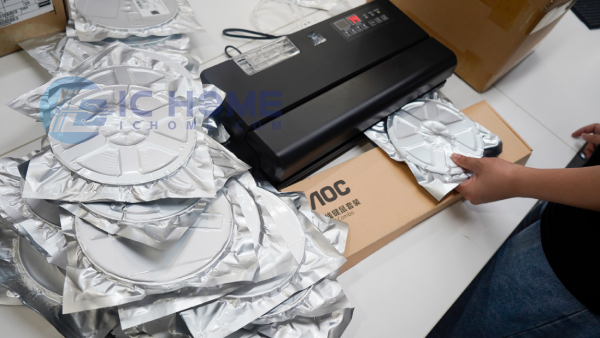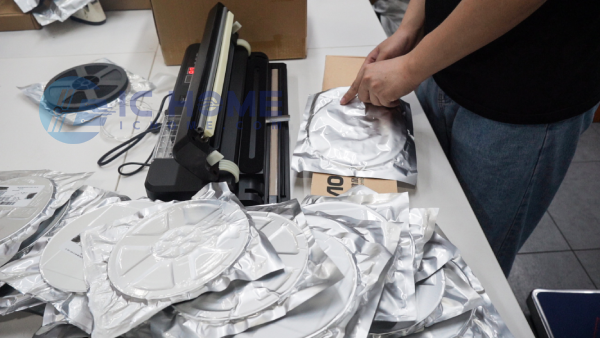How Component Vacuum Packaging Protects Electronics & What to Do After Opening
In the electronics supply chain, vacuum or “dry pack” packaging is more than just a neat storage method — it’s a critical safeguard that protects sensitive components from moisture, oxidation, and electrostatic damage. For many moisture-sensitive devices (MSDs) and ESD-sensitive components, proper packaging is the first step in ensuring reliability during assembly.
At ICHOME, we collaborate closely with global manufacturers and OEMs to ensure components reach you in the pristine condition in which they were produced. Here’s a detailed look at how vacuum packaging works, and what you should do the moment you open it.
How Vacuum Packaging Works
1. Moisture Barrier Bags (MBBs)
Most components are sealed inside multi-layer barrier bags made from PET/Aluminum/PE laminates. This composite structure combines physical strength with an extremely low Moisture Vapor Transmission Rate (MVTR), preventing ambient humidity from penetrating.
2. Vacuum Sealing or Nitrogen Flush
Before sealing, the air inside the bag is either vacuum-evacuated or replaced with dry nitrogen. Removing oxygen helps reduce oxidation risks, while lowering moisture levels reduces the chances of “popcorning” — a failure mode caused by trapped moisture rapidly vaporizing during reflow soldering.
3. Desiccants Inside
Silica gel or molecular sieve packets are placed inside the bag to actively absorb any residual moisture. Even with an effective seal, trace humidity may remain inside — desiccants handle this critical final step.
4. Humidity Indicator Card (HIC)
The HIC changes color based on internal humidity levels, allowing users to verify dryness at the moment of opening. Typically, the HIC displays spots corresponding to 10%, 20%, and 30% relative humidity, providing a quick visual reference.
5. Traceability Labels
Each bag is labeled with product details, lot codes, packing dates, and Moisture Sensitivity Level (MSL) ratings. This information helps track storage duration and floor life once the package is opened.


Why Moisture Sensitivity Matters
Moisture-sensitive devices absorb water from the environment. When exposed to the high temperatures of reflow soldering, this moisture expands into vapor, potentially cracking the component package — a phenomenon known as “popcorning.”
Industry standards such as JEDEC J-STD-033 define MSL (Moisture Sensitivity Level) categories and specify the maximum allowable “floor life” — the time components can be exposed to typical manufacturing conditions (30°C / 60% RH) before moisture-related damage risk increases. Depending on the MSL, this floor life ranges from unlimited (MSL 1) to as short as 24 hours (MSL 5a). For MSL 6 devices, no floor life is allowed outside sealed packaging; these components must be baked before use if removed from their moisture barrier bags.
Opening a Vacuum-Packed Component: Best Practices
To maintain quality and prevent damage, follow this checklist immediately after unsealing:
-
Open in an ESD-Safe Area
Use grounded mats and wrist straps. Moisture isn’t the only threat — static discharge can also destroy sensitive devices. -
Check the HIC Immediately
If the indicator shows internal humidity has exceeded safe limits, stop and assess whether baking is required before use. -
Record the Open Date and Time
This starts the floor-life clock. Write the open time on the reel or tray label for easy reference. -
Inspect the Components Visually
Look for corrosion, discoloration, or mechanical damage before moving to production. -
Follow MSL Guidelines Strictly
Use components within their allowed floor life. If exceeded, follow the manufacturer’s baking procedure before reflow soldering.
What If Floor Life Is Exceeded?
If parts remain unused beyond their floor life, they must be baked to remove absorbed moisture before assembly. Baking conditions vary by package size and MSL but typically involve heating between 40°C and 125°C for a specified duration as per JEDEC guidelines. After baking, parts should be re-sealed with fresh desiccant and a new HIC if they are not immediately assembled.
Handling Partial Reels or Trays
Often, you may consume only part of a reel. Simply resealing with ordinary tape is not enough — it does not restore moisture barrier properties. Best practices include:
-
Placing remaining components in a fresh moisture barrier bag with new desiccant and HIC.
-
Vacuum-sealing or storing them in a humidity-controlled dry cabinet (<10% RH).
-
Re-labeling with the new seal date and updated floor-life information.
Conclusion
-
Vacuum/dry packaging is a carefully engineered system combining physical barriers, moisture control, and traceability.
-
Every element—from the laminate film to the HIC—plays a vital role in maintaining component integrity.
-
Once the seal is broken, moisture control becomes your responsibility. Follow MSL guidelines, track open times, and bake if needed to prevent defects.
-
Proper resealing and storage of unused parts can extend their usability and reduce waste.
At ICHOME, we recognize that packaging is not just about shipping — it’s an integral part of ensuring component reliability. By handling vacuum-sealed components correctly from the moment they arrive, you safeguard performance, prevent costly failures, and keep your production running smoothly.




